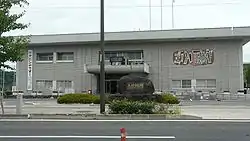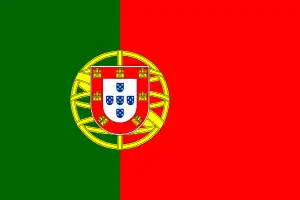Ōmura, Nagasaki
Ōmura (大村市, Ōmura-shi) is a city located in Nagasaki Prefecture, Japan. As of August 1, 2023, the city has an estimated population of 96,508[1] and a population density of 750 persons per km2. Its total area is 126.33 km2, and it includes Nagasaki Airport.
Ōmura
大村市 | |
|---|---|
 Ōmura City Hall | |
 Flag  Emblem | |
 Location of Ōmura in Nagasaki Prefecture | |
 Ōmura Location in Japan | |
| Coordinates: 32°54′0″N 129°57′30″E | |
| Country | Japan |
| Region | Kyushu |
| Prefecture | Nagasaki Prefecture |
| Government | |
| • Mayor | Hiroshi Sonoda |
| Area | |
| • Total | 126.34 km2 (48.78 sq mi) |
| Population (August 1, 2023) | |
| • Total | 96,508 |
| • Density | 760/km2 (2,000/sq mi) |
| Time zone | UTC+09:00 (JST) |
| City hall address | 1-25 Kushima, Omura-shi, Nagasaki-ken 856-8686 |
| Climate | Cfa |
| Website | www |
| Symbols | |
| Flower | Omura sakura |
| Tree | Quercus gilva |
History
Ōmura is a castle town, and was the capital of Ōmura Domain, ruled by the local Ōmura clan for over 900 years in pre-Meiji Japan. It was the site of considerable foreign trade and missionary activity during the late Muromachi period, and the Catholic saint Marina de Omura hails from this city. Due to its proximity to the trading settlement at Dejima in Nagasaki, was one of the first areas of Japan to re-open to foreign contact after the end of the national seclusion policy after the Meiji Restoration. In the opera Madama Butterfly, set in nearby Nagasaki, the place name Omara in the line "ed alla damigella Butterfly del quartiere d'Omara Nagasaki" probably refers to Ōmura. From 1868-1945, Ōmura was host to numerous military facilities as part of the Sasebo Naval District, most notably that of a major air base for the Imperial Japanese Navy Air Service. The former naval base was the location of the squalid[2] Ōmura Migrant Detention Center, where mainly Korean refugees—termed "stowaways" (mikkōsha synonymous with "smuggler")—were held until deportation, frequently for several years. Since August 1996 the nearby Ōmura Immigration Reception Center in a modern building serves the same function.[3]
The modern city was founded in 1942 after a town and several villages were municipalized by the prefecture.[4] The city was largely destroyed by American bombing in 1944. After the war, Omura hosted Japan's first motorboat racing event in 1952. Additionally in 1975, the city opened the world's first island airport; Nagasaki Airport which is located offshore in Ōmura Bay. The airport was constructed by reclaiming land on Minoshima Island after the island's residents agreed to relocate to replace the former airport which is now used by the Japan Maritime Self-Defense Force.[4][5]
Geography
Surrounding municipalities
- Nagasaki Prefecture
- Saga Prefecture
Climate
Ōmura has a humid subtropical climate (Köppen:Cfa) with hot summers and cool winters. The average annual temperature in Ōmura is 17.3 °C (63.1 °F). The average annual rainfall is 1,811.1 mm (71.30 in) with June and July as the wettest month. The temperatures are highest on average in August, at around 28.3 °C (82.9 °F), and lowest in January, at around 6.7 °C (44.1 °F).[6] Its record high is 38.7 °C (101.7 °F), reached on 12 August 2018, and its record low is −6.2 °C (20.8 °F), reached on 25 January 2016.[7]
| Climate data for Ōmura (1996−2020 normals, extremes 1996−present) | |||||||||||||
|---|---|---|---|---|---|---|---|---|---|---|---|---|---|
| Month | Jan | Feb | Mar | Apr | May | Jun | Jul | Aug | Sep | Oct | Nov | Dec | Year |
| Record high °C (°F) | 20.3 (68.5) |
22.0 (71.6) |
25.0 (77.0) |
28.3 (82.9) |
31.7 (89.1) |
36.2 (97.2) |
37.2 (99.0) |
38.7 (101.7) |
36.0 (96.8) |
32.2 (90.0) |
26.3 (79.3) |
24.9 (76.8) |
38.7 (101.7) |
| Average high °C (°F) | 10.5 (50.9) |
12.0 (53.6) |
15.5 (59.9) |
20.3 (68.5) |
24.6 (76.3) |
27.3 (81.1) |
30.8 (87.4) |
32.6 (90.7) |
29.3 (84.7) |
24.5 (76.1) |
18.6 (65.5) |
12.9 (55.2) |
21.6 (70.8) |
| Daily mean °C (°F) | 6.7 (44.1) |
7.6 (45.7) |
10.7 (51.3) |
15.2 (59.4) |
19.7 (67.5) |
23.3 (73.9) |
27.1 (80.8) |
28.3 (82.9) |
25.0 (77.0) |
20.0 (68.0) |
14.4 (57.9) |
9.0 (48.2) |
17.3 (63.1) |
| Average low °C (°F) | 2.9 (37.2) |
3.5 (38.3) |
6.2 (43.2) |
10.8 (51.4) |
15.5 (59.9) |
20.0 (68.0) |
24.3 (75.7) |
25.1 (77.2) |
21.6 (70.9) |
15.9 (60.6) |
10.4 (50.7) |
5.3 (41.5) |
13.5 (56.2) |
| Record low °C (°F) | −6.2 (20.8) |
−4.7 (23.5) |
−0.9 (30.4) |
2.7 (36.9) |
7.7 (45.9) |
12.8 (55.0) |
18.0 (64.4) |
19.1 (66.4) |
13.3 (55.9) |
7.6 (45.7) |
2.1 (35.8) |
−2.4 (27.7) |
−6.2 (20.8) |
| Average precipitation mm (inches) | 57.4 (2.26) |
77.4 (3.05) |
112.6 (4.43) |
143.5 (5.65) |
158.0 (6.22) |
305.5 (12.03) |
305.5 (12.03) |
221.1 (8.70) |
179.7 (7.07) |
94.3 (3.71) |
88.3 (3.48) |
67.7 (2.67) |
1,811.1 (71.30) |
| Average precipitation days (≥ 1.0 mm) | 8.0 | 8.3 | 10.2 | 9.2 | 8.7 | 12.7 | 11.0 | 10.2 | 9.0 | 5.8 | 7.9 | 8.1 | 109.1 |
| Source: Japan Meteorological Agency[7][6] | |||||||||||||
Demographics
Per Japanese census data, the population of Ōmura in 2022 is 98,237 people.[8] Ōmura has been conducting censuses since 1960. Although the city's population declined slightly in the 1960s, Ōmura's population has been growing since 1970.
| Year | Pop. | ±% |
|---|---|---|
| 1960 | 59,752 | — |
| 1965 | 56,425 | −5.6% |
| 1970 | 56,538 | +0.2% |
| 1975 | 60,919 | +7.7% |
| 1980 | 65,538 | +7.6% |
| 1985 | 69,472 | +6.0% |
| 1990 | 73,435 | +5.7% |
| 1995 | 79,279 | +8.0% |
| 2000 | 84,414 | +6.5% |
| 2005 | 88,040 | +4.3% |
| 2010 | 90,528 | +2.8% |
| 2015 | 92,757 | +2.5% |
| 2020 | 95,397 | +2.8% |
| Ōmura population statistics[8] | ||
Transportation
Air
Railways
- JR Kyushu
- Nishi Kyushu Shinkansen: Shin-Ōmura
- Ōmura Line: Matsubara - Omura Depot - Takematsu - Shin-Ōmura - Suwa - Omura - Iwamatsu
Economy
Ōmura has a mixed economy, with the manufacture of refractory bricks as a major industry. Dairy and poultry farming, as well as cultured pearls are also of importance. However, due to its proximity to the larger urban centers of Nagasaki and Sasebo, Ōmura also serves as bedroom community for both cities.
Oriental Air Bridge, a regional airline, is headquartered in the city.[9] At one time J-Air had its headquarters at the airport.[10]
Sports
Ōmura hosted the official 2011 Asian Basketball Championship for Women.
Sister City relations
 Sintra, Portugal[11]
Sintra, Portugal[11] San Carlos, California, USA[11]
San Carlos, California, USA[11] Semboku, Akita, Japan[11]
Semboku, Akita, Japan[11] Itami, Hyōgo, Japan[11]
Itami, Hyōgo, Japan[11]
Friendly Cities
 Minhang District, Shanghai, China[11]
Minhang District, Shanghai, China[11]
Notable people
- Hantaro Nagaoka, Meiji-era physicist
- Anza Ohyama, singer and stage actress
- Masaki Okino, footballer
- Taira Shige, footballer
References
- "大村市推計人口" (in Japanese). Japan: Ōmura City. Retrieved 9 August 2023.
- "East Asian version of the Nazi concentration camps ... We should not be misled by the facts that it has no gas chambers ..." Hayashi Kōzō, cit. in: Morris-Suzuki, Tessa; Borderline Japan: foreigners and frontier controls in the post-war era; Cambridge 2010; ISBN 978-0-521-86460-2, p. 167
- Morris-Suzuki, Tessa; Borderline Japan: foreigners and frontier controls in the post-war era; Cambridge 2010; ISBN 978-0-521-86460-2. Ch. 6
- "The History of Omura" (in Japanese). Japan: Ōmura City. Retrieved 22 November 2022.
- "長崎空港のなりたち" (in Japanese). Japan: Nagasaki Airport. Retrieved 22 November 2022.
- 気象庁 / 平年値(年・月ごとの値). JMA. Retrieved March 30, 2022.
- 観測史上1~10位の値(年間を通じての値). JMA. Retrieved March 30, 2022.
- Ōmura population statistics
- "オリエンタルエアブリッジ株式会社." Oriental Air Bridge. Retrieved on May 20, 2009.
- "World Airline Directory." Flight International. March 19–25, 2002. 80.
- 大村市. "Sister Cities and a Friendly City". 大村市. Retrieved 2020-06-24.
External links
- Ōmura City official website (in English)